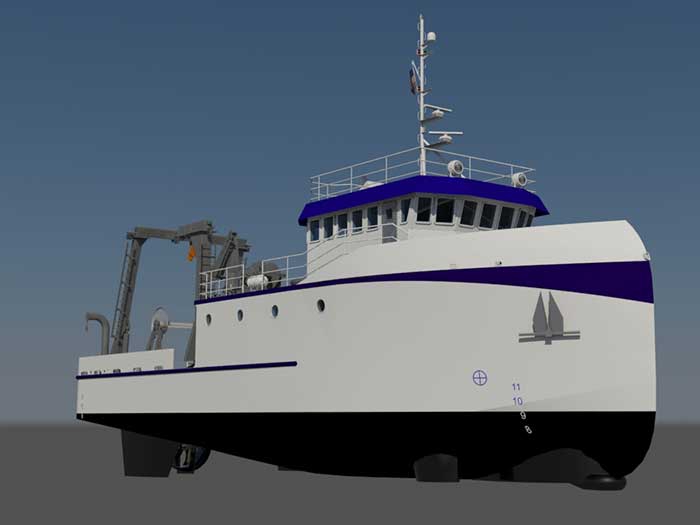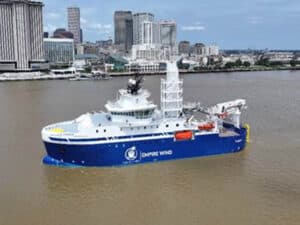
VIMS orders 93 ft research vessel
Written by Nick Blenkey
JANUARY 12, 2017 — Virginia Institute of Marine Science of Gloucester Point, VA, has awarded Matane, Quebec, shipyard Meridien Maritime Réparation a contract construct a 93-ft research vessel.
Designed by JMS Naval Architects, Mystic, CT, it will replace the institute’s current vessel, the R/V Bay Eagle.
The primary mission of the institute’s fleet is to provide inshore and offshore work platforms for the support of fisheries related oceanographic research projects. The new vessel will be capable of conducting fisheries assessments of greater capacity, in deeper waters and with a larger science complement than the Bay Eagle. In addition, it will greatly expand VIMS’s capability to perform general oceanographic research in the Chesapeake Bay and the mid-Atlantic near coastal waters.
JMS designed the vessel to operate as an uninspected research vessel with an ABS loadline. The design offers flexibility in science outfitting allowing for high utilization and affordable operating day rates. The vessel is easily adaptable to evolving scientific research areas such as offshore oil & gas exploration surveys, wind energy development surveys, environmental impact studies, and the servicing of ocean observing systems.
Main propulsion is provided by a pair of 660 BHP tier III diesel engines coupled to a two–in/one-out marine gear driving a controllable pitch propeller shrouded within a nozzle.
The arrangement will provide the capability to operate the vessel on a single propulsion engine when on station or during slow speed transits. This will reduce overall engine hours and thus reduce the cost of operation and improve fuel efficiency, minimizing its environmental footprint.
The gearbox also powers a robust hydraulic system required to support the vessel’s deep water trawl winches and load handling equipment.
Electrical requirements are met by a pair of 99 ekW generators which provide redundant capability or can be run in parallel during peak power demands.
LED lighting will reduce both power consumption and heat emitted into the accommodation spaces.
A high performance rudder package and 250 HP omnidirectional flush -mounted grid bow thruster provide excellent maneuverability. The vessel’s capabilities are further enhanced by a state-of-the-art dynamic positioning system for station keeping.
Oceanographic outfitting includes very large Wet and Dry Labs designed for maximum flexibility. A 1,000 sq.ft main working deck allows for a 20 long ton science payload and provides a working platform forfishing operations, over-the-side sampling and coring activities.
There is also ample room and services to install a 20 foot science van for specialized missions.
The new research vessel will take advantage of the latest technology through an extensive array of acoustic instrumentation for the gathering and processing of data in support of fisheries research, oceanography and geophysical sciences.
The aft deck is fitted with a stern A-Frame with an 8,000 lb safe working load for over the stern lifting operations and a side mounted J-Frame with an 4,000 lb safe working load for conducting CTD operations.
The principal fishing arrangement consists of a pair of trawl net reels and a pair of trawl winches with 4,000 lb linear pull with 355 fathoms of 3/8″ wire to support small mesh (200 mm net) bottom trawl surveys inshore and nearshore waters. An electric CTD (Conductivity, Temperature, and Depth) winch with 2,000 m of 0.322″ wire will also be fitted for operation from the side mounted J-Frame. There is also a knuckle boom deck crane with a 2,240 lb capacity at a 33 foot reach to support load handling operations.







Leave a Reply
You must be logged in to post a comment.